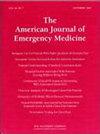The use of the Roth score in emergency department for patients with acute exacerbation of chronic obstructive pulmonary disease
IF 2.7
3区 医学
Q1 EMERGENCY MEDICINE
引用次数: 0
Abstract
Introduction
This study investigated the feasibility of using the Roth score in the emergency setting to make hospitalization or discharge decisions for patients with acute exacerbations of chronic obstructive pulmonary disease (AECOPD).
Materials and methods
This study was conducted prospectively between March 1, 2023 and January 1, 2024 and included 101 patients with Group E chronic obstructive pulmonary disease who were treated in the emergency department of a tertiary hospital. The patients were categorized into two groups: those who were hospitalized and those who were discharged. The Roth score, determined by measuring patients' breath-holding times after forced inspiration and counting rhythmically, was measured in seconds and counted. Changes in Roth scores, arterial blood gas parameters, and transcutaneous oxygen saturation levels measured during AECOPD presentation and after appropriate treatment were examined.
Results
The study included 101 patients (57 males, 44 females) with a mean age of 61.4 years. After AECOPD treatment, the area under the curve for the Roth score was 0.937 s for the duration and 0.969 for the count. At a cut-off value of 9.5 s, the Roth score in seconds had a sensitivity of 92 % and a specificity of 75 %. At a cut-off value of 10.5, the Roth score had a sensitivity of 97 % and a specificity of 70 %.
Conclusion
The Roth score (only counts) increased in discharged patients after AECOPD treatment. It appears to be a viable method for predicting hospitalization or discharge decisions in patients with AECOPD who present to the emergency department.
急诊科对慢性阻塞性肺病急性加重患者使用罗氏评分。
简介:本研究探讨了在急诊环境中使用罗氏评分来决定慢性阻塞性肺疾病(AECOPD)急性加重患者住院或出院的可行性:本研究于 2023 年 3 月 1 日至 2024 年 1 月 1 日期间进行,包括在一家三级医院急诊科接受治疗的 101 名 E 组慢性阻塞性肺病患者。这些患者被分为两组:住院患者和出院患者。罗氏评分通过测量患者用力吸气后的屏气时间并有节奏地计数来确定,以秒为单位并计数。对 AECOPD 发病时和适当治疗后测量的 Roth 评分、动脉血气参数和经皮血氧饱和度水平的变化进行了研究:研究包括 101 名患者(57 名男性,44 名女性),平均年龄为 61.4 岁。AECOPD 治疗后,罗氏评分曲线下的持续时间为 0.937 秒,计数为 0.969 秒。截断值为 9.5 秒时,以秒为单位的 Roth 评分的灵敏度为 92%,特异度为 75%。截断值为 10.5 时,罗氏评分的灵敏度为 97%,特异度为 70%:结论:AECOPD 治疗后,出院患者的 Roth 评分(仅计数)增加。它似乎是预测急诊科 AECOPD 患者住院或出院决定的可行方法。
本文章由计算机程序翻译,如有差异,请以英文原文为准。
求助全文
约1分钟内获得全文
求助全文
来源期刊
CiteScore
6.00
自引率
5.60%
发文量
730
审稿时长
42 days
期刊介绍:
A distinctive blend of practicality and scholarliness makes the American Journal of Emergency Medicine a key source for information on emergency medical care. Covering all activities concerned with emergency medicine, it is the journal to turn to for information to help increase the ability to understand, recognize and treat emergency conditions. Issues contain clinical articles, case reports, review articles, editorials, international notes, book reviews and more.

 求助内容:
求助内容: 应助结果提醒方式:
应助结果提醒方式:


